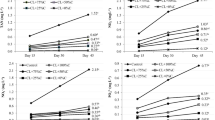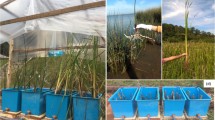Abstract
Seasonal growth characteristics and biomass yield potential of 4 small-leaf, floating, aquatic macrophytes cultured in nutrient nonlimiting conditions were evaluated for central Florida’s climatic conditions. Biomass yields were found to be 10.6, 11.3, 16.1, and 32.1 t (dry wt) har−1 yr−1, respectively, for azolla (Azolla caroliniana), giant duckweed (Spirodela polyrhiza), common duckweed (Lemna minor), and salvinia (Salvinia rotundifolia). Operational plant density was in the range of 10–80 g dry wt m−2 for azolla, 10–88 g dry wt m−2 for giant duckweed, 10–120 g dry wt m−2 for common duckweed, and 35–240 g dry wt m−2 for salvinia. Specific growth rate (% increase per day) was maximum at low plant densities and decreased as the plant density increased. Results suggest that small-leaf, floating plants may not be suitable in monoculture biomass production systems because of low biomass yields, but they may be suitable for inclusion in poly culture systems with larger aquatic plants. The high N content (crude protein = 20–33%) of small-leaf,floating plants suggests the use of biomass as animal feed.
Similar content being viewed by others
Literature Cited
A.P.H.A. 1980. Standard methods for the examination of water and wastewater. 15th ed, p. 1134. American Public Health Association. Washington, DC.
Boyd, C. E. 1970. Vascular aquatic plants for mineral nutrient removal from polluted waters. Econ. Bot. 24: 95–103.
Cornwell, D. A., J. Zoltek, Jr., C. D. Patrinely, T. des Furman, and J. I. Kim. 1977. Nutrient removal by water hyacinths. J. Water Pollut. Control Fed. 49: 57–65.
Culley, D. D., Jr., and A. E. Epps. 1973. Use of duckweed for waste treatment and animal feed. J. Water Pollut. Control Fed. 45: 337–347.
DeBusk, T. A., J. H. Ryther, M. D. Hanisak, and L. D. Williams. 1981. Effects of seasonality and plant density on the productivity of some freshwater macrophytes. Aquatic Bot. 10: 133–142.
Harvey, R. M., and J. L. Fox. 1973. Nutrient removal using Lemna minor. J. Water Pollut. Control Fed. 45: 1928–1938.
Jackson, G. A. 1980. Marine biomass production through seaweed aquaculture. In A. San Pietro, ed, Biochemical and Photosynthetic Aspects of Energy Production, p. 31–58. Academic, New York.
Jackson, M. L. 1958. Soil Chemical Analysis, p. 498. Prentice-Hall, London.
Lakshman, G. 1979. An ecosystem approach to the treatment of wastewaters. J. Environ. Qual. 8: 353–361.
Lumpkin, T. A., and D. L. Plucknett. 1980.Azolla: botany, physiology, and use as a green manure. Econ. Bot. 34: 111–153.
Reddy, K. R., and W. F. DeBusk. 1984a. (in press). Phosphorus removal potential ofAzolla caroliniana cultured in nutrient-enriched waters. In W. S. Silver and B. C. Schroder, ed, Symp. Proc. Practical Applications of Azolla in Rice Production. Nov. 17–19,1982, Mayaguez, Puerto Rico. Martinus Nijhoff/Dr. W. Junk, The Hague.
—, and —. 1984b. Growth characteristics of aquatic macrophytes cultured in nutrient-enriched water: I. Water hyacinth, water lettuce, and pennywort. Econ. Bot. 38: 229–239.
—, D. L. Sutton, and G. E. Bowes. 1983. Biomass production of freshwater aquatic plants in Florida. Proc. Soil Soc. Florida 42: 28–40.
—, K. L. Campbell, D. A. Graetz, and K. M. Portier. 1982. Use of biological niters for agricultural drainage water treatment. J. Environ. Qual. 11: 591–595.
Sutton, D. L., and W. H. Ornes. 1975. Phosphorus removal from static sewage effluent using duckweed. J. Environ. Qual. 4: 367–370.
—, and —. 1977. Growth ofSpirodela polyrhiza in static sewage effluent. Aquatic Bot. 3: 231–237.
Talley, S. N., B. J. Talley, and D. W. Rains. 1977. Nitrogen fixation byAzolla in rice fields. In A. Hollaender, ed, Genetic Engineering for Nitrogen Fixation, p. 259–281. Plenum, New York.
Tran, Q. T., and T. T. Dao. 1973.Azolla: A green compost. Vietnamese Studies 38, Agric. Problems, Agron. Data 4: 119–127 (cited by Lumpkin, T. A., and D. L. Plucknett, 1980, Econ. Bot. 34: 111–153).
Watanabe, I., C. R. Espinas, N. C. Berja, and V. B. Alimagno. 1977. Utilization of theAzolla-Anabaena complex as a nitrogen fertilizer for rice. Int. Rice Res. Inst. Phillipines. Res. Paper Ser. No. 11, p. 1–15.
Wedge, R. M., and J. E. Burns. 1982. Effects of light and temperature on duckweed photosynthesis. Aquat. Bot. 12: 133–140.
Wolverton, B. C. 1982. Hybrid wastewater treatment system using anaerobic microorganisms and reed (Phragmites communis). Econ. Bot. 36: 373–380.
—, and R. C. McDonald. 1979. Upgrading facultative wastewater lagoons with vascular aquatic plants. J. Water Pollut. Control Fed. 51: 305–313.
Author information
Authors and Affiliations
Additional information
Florida Agricultural Experiment Stations Journal Series No. 5928.
Rights and permissions
About this article
Cite this article
Reddy, K.R., DeBusk, W.F. Growth characteristics of aquatic macrophytes cultured in nutrient-enriched water: II. Azolla, Duckweed, and Salvinia. Econ Bot 39, 200–208 (1985). https://doi.org/10.1007/BF02907846
Received:
Accepted:
Issue Date:
DOI: https://doi.org/10.1007/BF02907846




